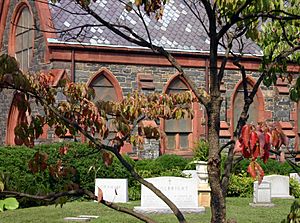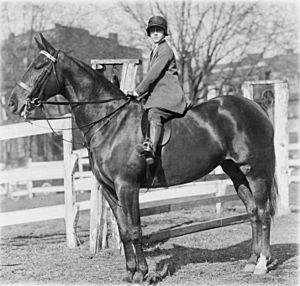Katharine Graham facts for kids
Quick facts for kids
Katharine Graham
|
|
|---|---|

Graham in 1975
|
|
| Born |
Katharine Meyer
June 16, 1917 New York City, New York, U.S.
|
| Died | July 17, 2001 (aged 84) Boise, Idaho, U.S.
|
| Resting place | Oak Hill Cemetery Washington, D.C., U.S. |
| Education | Vassar College University of Chicago (BA) |
| Occupation | Newspaper publisher |
| Spouse(s) |
Philip Graham
(m. 1940; died 1963) |
| Children | 4, including Lally and Donald |
| Parent(s) | Eugene Meyer Agnes E. Meyer |
| Family | Florence Meyer (sister) Marc Eugene Meyer (grandfather) Joseph Newmark (great-grandfather) |
Katharine Meyer Graham (June 16, 1917 – July 17, 2001) was an important American newspaper publisher. She led her family's newspaper, The Washington Post, for many years. From 1963 to 1991, she was in charge.
Graham was the first woman to publish a major American newspaper in the 20th century. She was also the first woman chosen for the board of the Associated Press. Her book about her life, Personal History, won a special award called the Pulitzer Prize in 1998.
Contents
Katharine's Early Life
Katharine Meyer was born in 1917 in New York City. Her family was very wealthy. Her father, Eugene Meyer, was a successful financier. He later became the head of the Federal Reserve.
In 1933, Katharine's father bought The Washington Post newspaper. Her mother, Agnes Elizabeth, was an intellectual and involved in politics. Katharine grew up with four siblings. She often spent time with nannies and tutors because her parents traveled a lot.
Katharine went to The Madeira School. Then she studied at Vassar College before moving to the University of Chicago. While in Chicago, she became very interested in issues facing workers. She made friends with people from many different backgrounds.
Starting Her Career
After college, Katharine worked for a short time at a newspaper in San Francisco. She helped report on a big strike by workers there. In 1938, she started working for The Washington Post.
On June 5, 1940, Katharine married Philip Graham. He was a lawyer who had worked for a Supreme Court Justice. They had four children: a daughter named Lally and three sons, Donald, William, and Stephen.
Leading The Washington Post
In 1946, Katharine's father gave control of the Post to her husband, Philip. Katharine wrote in her book that she was happy about this. She didn't think of herself as someone who would run the newspaper at that time.
Philip Graham became the publisher of the Post. The company grew, buying TV stations and Newsweek magazine. After Philip's death in 1963, Katharine Graham took over. She became the president of the company and the main leader of the Post.
From 1969 to 1979, she was officially the publisher. From 1973 to 1991, she was the chairwoman of the board. In 1972, she became the first female CEO of a Fortune 500 company. This was a very high position.
At first, it was hard for Katharine to be taken seriously by men in the publishing world. She often felt unsure of herself. But as the women's rights movement grew, her confidence also grew. She worked to make things more equal for women at her company. She hired Benjamin Bradlee as the editor. She also got financial advice from Warren Buffett, a famous investor.
The Watergate Scandal
Katharine Graham led the Post during a very important time. The newspaper played a key role in uncovering the Watergate scandal. This scandal eventually led to President Richard Nixon resigning from office.
The Post faced challenges when it published parts of the Pentagon Papers. Later, Post reporters Bob Woodward and Carl Bernstein started reporting on Watergate. Katharine Graham strongly supported their investigative work. She allowed the Post to publish stories about Watergate, even when other news outlets were not.
During the Watergate scandal, the Post received a famous threat. In 1972, President Nixon's attorney general, John Mitchell, warned reporter Carl Bernstein about a story. He said, "Katie Graham's gonna get her tit caught in a big fat wringer if that's published." The Post published the quote, but left out some words. Graham later said it was strange he called her "Katie," as no one else did.
Press and Government Secrets
Katharine Graham believed in a balance between the press and government secrets. In 1988, she gave a speech at the CIA. She said, "We live in a dirty and dangerous world. There are some things the general public does not need to know, and shouldn't." She also said, "I believe democracy flourishes when the government can take legitimate steps to keep its secrets and when the press can decide whether to print what it knows."
Awards and Recognition

Katharine Graham received many awards and honors for her work.
- In 1966, she was the special guest at Truman Capote's famous Black and White Ball.
- In 1973, she received the Elijah Parish Lovejoy Award.
- In 1974, she was the first woman elected to the board of directors at the Associated Press.
- In 1975, she received an award for public service from the Jefferson Awards.
- In 1987, she won the Walter Cronkite Award for Excellence in Journalism.
- In 1997, she published her autobiography, Personal History. The book was praised for being honest and showing how women's roles changed. It won the Pulitzer Prize in 1998.
- In 1999, she received the Golden Plate Award from the American Academy of Achievement.
- In 2002, after her death, she was given the Presidential Medal of Freedom by President George W. Bush.
- Also in 2002, she was added to the National Women's Hall of Fame.
In 2017, actress Meryl Streep played Katharine Graham in the movie The Post. Streep was nominated for an Academy Award for her role.
Later Life and Death
On July 14, 2001, Katharine Graham fell and hit her head while visiting Sun Valley, Idaho. She passed away three days later at the age of 84. Her funeral was held at the Washington National Cathedral. She is buried in Oak Hill Cemetery in Washington, D.C.
See also
 In Spanish: Katharine Graham para niños
In Spanish: Katharine Graham para niños



